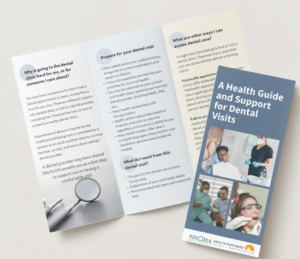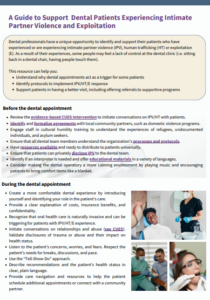Oral Health
According to an article published in the The Journal of the American Dental Association, more than half of dentists could not identify a referral for patients experiencing IPV. In several studies survivors of IPV saw a dentist when signs of abuse were present and many were not asked about their injuries (as many as 88.6% in one study). Oral health providers have an opportunity to offer their patients information on IPV, reduce isolation, and increase safety by referring patients to community-based organizations for support.
See below for related webinars, learning collaboratives, and resources:

A Health Guide and Support for Dental Visits (Brochure)
This brochure may be stocked in exam rooms and shared by oral health staff with their patients as part of the evidence-based CUES Intervention. The brochure offers trauma-informed tips to help patients have comfortable visits and know what to expect during an oral health visit. Included are strategies and national resources on domestic violence, medical care and health centers.

A Guide to Supporting Patients Experiencing Violence and Abuse
This fact sheet guides oral health professionals on how to provide inclusive and sensitive care to patients who have experiences of violence or trauma, including intimate partner violence (IPV), human trafficking (HT) or exploitation (E). The 2-page guide outlines the role of oral health staff in providing care to survivors, including before and during patient visits, and how to develop partnerships with community programs to help increase patient access to safety support. Included are links to HRSA’s Strategy to Address IPV, and resources like the National Domestic Violence Hotline and free cosmetic dentistry programs for survivors of violence.


